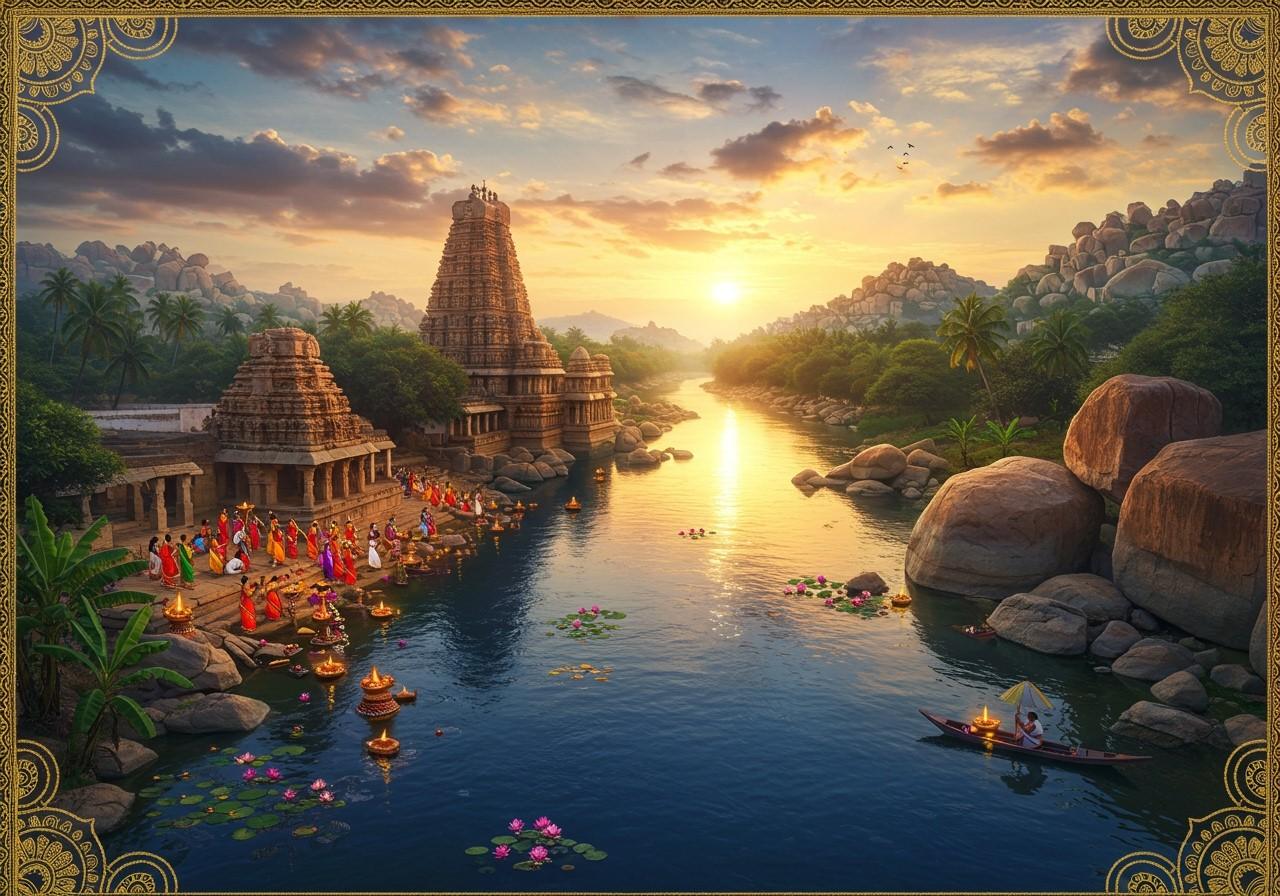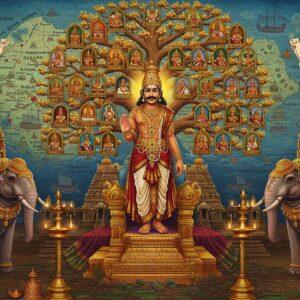
The Tungabhadra River, coursing through Karnataka, is more than just a scenic waterway; it’s a spiritual artery for countless individuals. This exploration delves into the river’s captivating history, mythical significance, and the sacred sites that grace its banks. Understanding the Tungabhadra’s profound cultural and religious impact enriches one’s appreciation of South India’s heritage.
Historical Significance of the Tungabhadra River
The Tungabhadra River originates from the sacred union of the Tunga and Bhadra rivers in the heart of Karnataka, a confluence imbued with legends linked to Lord Vishnu’s Varaha avatar. Its journey spans Karnataka and Andhra Pradesh, nourishing life and shaping history along its course. Ancient trade routes flourished along its waters, vital to early South Indian civilizations. The magnificent ruins of the Vijayanagara Empire in Hampi stand as a testament to the river’s crucial role in the empire’s prosperity, providing sustenance through irrigation and agriculture.
- Formation: Born from the confluence of the Tunga and Bhadra rivers, a site of mythological significance associated with Lord Vishnu.
- Route: Flows through Karnataka and Andhra Pradesh, shaping the landscape and history of both regions.
- Historical Sites: Hampi, a UNESCO World Heritage site, showcases the architectural marvels of the Vijayanagara Empire, deeply intertwined with the river’s history.
- Ancient Trade Routes: Served as a vital artery for trade and transportation, fostering economic and cultural exchange.
- Neolithic Settlements: Archaeological discoveries reveal evidence of settlements dating back to Neolithic times, highlighting the river’s long-standing importance to human habitation.
- Vijayanagara Empire: Played a crucial role in the empire’s agriculture and prosperity through irrigation, shaping its rise and fall.
- Historical Texts: Ancient inscriptions and texts bear witness to the river’s significance throughout history.
Even today, the Tungabhadra remains essential for regional progress and responsible water management.
Mythological Connections of the Tungabhadra
Shrouded in ancient lore, the Tungabhadra River finds mention in sacred texts like the Mahabharata. It is deeply connected to Hindu deities, particularly Lord Shiva and Goddess Durga. The poignant tale of King Harishchandra’s penance on its banks resonates through generations. Local folklore and oral traditions celebrate the river’s divine essence, culminating in annual rituals and festivals such as the Tungabhadra Pushkaram.
- Ancient Scriptures: Revered in the Mahabharata, solidifying its place in Hindu mythology.
- Deities: Associated with powerful deities like Lord Shiva and Goddess Durga, adding to its spiritual significance.
- King Harishchandra: The story of his penance on the riverbanks serves as a testament to its sacred power.
- Local Folklore: Rich oral traditions and local legends weave a tapestry of mythical connections around the river.
- Annual Festivals: The Tungabhadra Pushkaram, a vibrant festival, honors the river’s sanctity and draws devotees from far and wide.
These narratives deeply influence the cultural practices of the communities that thrive along the river’s edge.
Temples Along the Tungabhadra River
The Tungabhadra’s banks are graced by magnificent temples, each echoing with spiritual significance. The Virupaksha Temple in Hampi, a UNESCO World Heritage Site, captivates with its architectural grandeur. The Vijaya Vittala Temple, renowned for its musical pillars and iconic stone chariot, stands as a testament to artistic and engineering prowess. The Tungabhadra Dam area itself houses significant temple complexes, adding to the region’s spiritual aura.
- Virupaksha Temple: A UNESCO World Heritage site in Hampi, a masterpiece of architecture and a hub of devotion.
- Vijaya Vittala Temple: Famous for its unique musical pillars and the impressive stone chariot, a symbol of artistry and devotion.
- Tungabhadra Dam Area: Home to several important temple complexes, enriching the spiritual landscape of the region.
- Sacred Samadhi of Sri Raghavendra Swamy in Mantralayam: A revered pilgrimage site for devotees seeking blessings and spiritual solace.
- Jogulamba Temple in Alampur (Dakshina Kashi): Known as Dakshina Kashi, this temple holds immense significance as a Shakti Peetha.
These temples are not merely architectural marvels; they serve as spiritual anchors for devotees, resonating with centuries of faith and devotion. For those seeking a deeper connection with these sacred spaces, consider exploring the range of puja items available on Poojn.in. Our collection includes items such as pure copper kalash, brass deepam, kumkum, turmeric, cotton wicks, puja thali sets, coconuts and camphor.
Pilgrimage and Spiritual Practices
Pilgrims journey to the Tungabhadra River drawn by its spiritual allure. Bathing in its sacred waters is believed to cleanse sins and purify the soul. Pilgrimage routes often encompass visits to the temples that dot the riverbanks, guided by local priests who facilitate rituals and offer spiritual insights.
- Bathing Rituals: A deeply purifying act believed to cleanse sins and rejuvenate the soul.
- Pilgrimage Routes: Well-established routes connect key temples along the river, offering a structured spiritual journey.
- Local Guides and Priests: Provide valuable assistance with rituals and offer insights into the region’s spiritual heritage.
- Sringeri Pilgrimage Guide: While not directly on the Tungabhadra, Sringeri, with its Sharada Peetham, offers a complementary spiritual experience in Karnataka and can be easily combined with a Tungabhadra pilgrimage.
- Tirupati Pilgrimage Guide: Plan your pilgrimage to Tirupati, another significant spiritual destination in South India, with our comprehensive guide.
Modern conveniences, such as online booking for temple visits, enhance the traditional pilgrimage experience, making it more accessible to contemporary devotees.
Cultural Impact and Modern-Day Relevance
The Tungabhadra River’s influence on South Indian culture is profound and pervasive. Local art forms, music, and literature draw inspiration from its sacred presence. Festivals and community events centered around the river strengthen social bonds and reinforce cultural identity. Environmental movements champion the preservation of the river’s natural beauty, supported by government initiatives promoting cultural heritage tourism.
- Local Art and Music: The river’s beauty and spiritual significance inspire artistic expression in various forms.
- Festivals and Events: Community gatherings and celebrations along the riverbank foster unity and cultural continuity.
- Environmental Movements: Efforts to protect and preserve the river’s ecosystem highlight its importance to the region’s well-being.
- Government Initiatives: Promoting cultural heritage tourism recognizes the river’s value and contributes to its preservation.
The Tungabhadra continues to shape the cultural identity of South India, seamlessly blending tradition with modernity. This enduring legacy enriches the lives of those who live by its waters and those who journey to experience its sacred embrace.
How Poojn.in Helps You Connect with Tungabhadra’s Sacred Traditions
At Poojn.in, we offer a curated selection of puja essentials to help you honor and connect with the sacred traditions of the Tungabhadra River, even from the comfort of your home. Our offerings include:
- Shiva Lingam: Honor Lord Shiva, deeply connected to the Tungabhadra, with a sacred Shiva Lingam for your home altar.
- Pure Copper Kalash: Ideal for storing holy water from the Tungabhadra or conducting river-related rituals.
- Brass Deepam: Traditional oil lamps to illuminate your home altar and create a sacred ambiance during river-related ceremonies.
- Bel Mala: A sacred garland made from the Bilva leaves, traditionally offered to Lord Shiva.
- Kumkum and Turmeric: Sacred powders used for tilak and offerings, essential for various rituals.
- Cotton Wicks: A necessary component for performing aarti and lighting lamps during ceremonies.
- Puja Thali Sets: Complete sets containing all the essential items for performing river worship ceremonies with reverence.
- Coconuts: A significant offering in Hindu rituals, symbolizing purity and auspiciousness.
- Camphor: Used in aarti ceremonies to purify the atmosphere and invoke divine blessings.
These authentic items are sourced responsibly and delivered to your doorstep. Browse our complete collection at www.poojn.in. We offer pan-India shipping and secure payment options for a seamless shopping experience.
Conclusion
The Tungabhadra River is far more than a geographical entity; it represents a confluence of history, mythology, spirituality, and cultural richness in South India. From ancient civilizations to its modern-day relevance, the river stands as a timeless symbol of sustenance and spiritual significance. Its serene waters have witnessed the ebb and flow of empires, inspired countless expressions of art and music, and offered a sacred path for pilgrims seeking purification and blessings.
As we cherish the traditions and stories intertwined with the Tungabhadra River, it is our collective responsibility to safeguard its natural beauty and preserve its cultural heritage. Embracing modern tools like online temple bookings allows us to bridge tradition and contemporary life, ensuring that the sacred journey along the Tungabhadra continues to flourish for generations to come.


